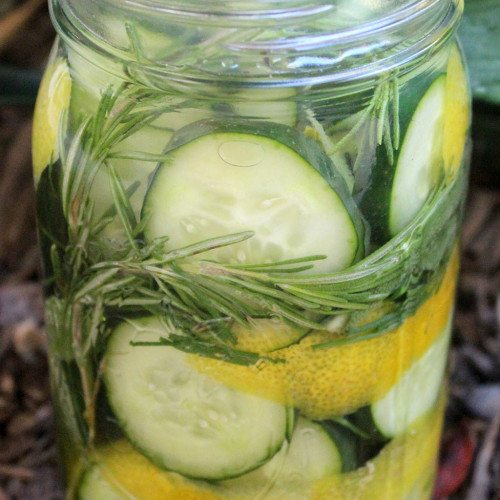Rosemary Sage Lemon Pickles
These have a wonderful flavor. I have found you can also make this recipe using zucchini instead of cucumbers.
Servings: 1 quart
Equipment
Ingredients
- ⅛ teaspoon Veggie Starter Culture or you can use ⅛ cup kefir whey
- 1 cup Water, spring or filtered with minerals to mix with culture packet
- 2 cups pickling cucumbers sliced
- ½ cup chives chopped
- 2-3 sprigs rosemary
- 4 - 8 sage leaves
- 1 tablespoon Celtic Sea Salt
- 1 lemon zest only
- 2 - 3 grape leaves cleaned, (*1) See note below
- Water, spring or filtered with minerals cold
- ¼ teaspoon Calcium Chloride optional see note*
Instructions
- If using the starter culture, stir together the culture and water. Let the mixture sit while you prepare the ingredients—around 10 minutes. If using kefir whey, add it when the recipe calls for culture.
- Slice cucumber into ¼-inch rounds.
- Tightly pack sliced cucumber herbs, salt, lemon, and grape leaves in a 16-ounce clean glass jar until about ¾ full.
- Add the Cutting Edge Cultures, or kefir whey, and fill the container with extra filtered water, leaving 2 inches of head space, as the vegetables will bubble and expand as they ferment.
- Seal the container and let it sit on your kitchen counter, out of direct sunlight, for 3 days. After 3 days, place the container in the refrigerator.
- Check the vegetables every day to make sure they are fully submerged in the water. If they have risen above the water, simply push them down so they are fully covered by the water. If any white spots formed because the veggies rose above the water, do not worry. Remember, this isn’t harmful. Just scoop out the vegetables that have the white spots on them and push the rest back under the water.
Notes
(*1) You can substitute the grape leaves with oak leaves, cherry leaves, raspberry leaves, or blackberry leaves. (There are tannins in the leaves that make the pickles crunchy. You can leave them out, but it makes a big difference in how crisp the pickles are.)
(*2) They are ready to eat after about a week but will keep fermenting and age much like a fine wine. I like them at about 2 to 3 weeks, but they will last nine months in your refrigerator.
Calcium chloride is a helpful ingredient that helps pickles stay crunchy and preserve their texture. I love how it helps my pickles stay crisp and adds a salty taste to pickles and other foods without increasing their sodium content. I noticed it in many popular fermented pickles in stores and decided to research it and try it myself with great results.Calcium chloride is an inorganic compound—a salt with the chemical formula CaCl2. It has a long history of safe use in food and is widely recognized as a safe food additive by major regulatory bodies worldwide. FDA Approval: The U.S. Food and Drug Administration (FDA) has granted calcium chloride Generally Recognized as Safe (GRAS) status for its intended uses in food.
www.CulturedFoodLife.com
